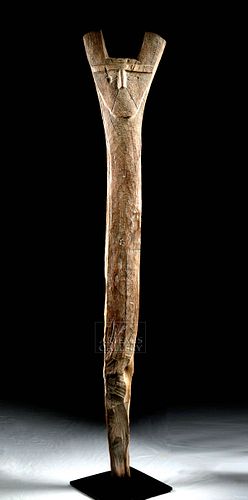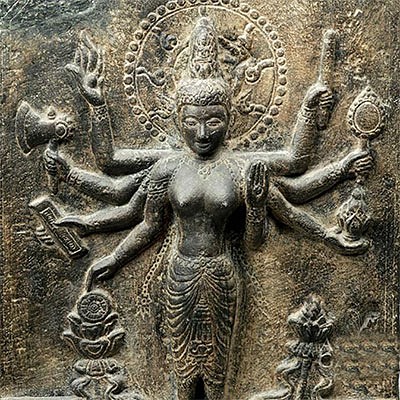Rare / Massive Huari Wooden Pillar
Lot 123a
About Seller
Artemis Gallery
686 S Taylor Ave, Ste 106
Louisville, CO 80027
United States
Selling antiquities, ancient and ethnographic art online since 1993, Artemis Gallery specializes in Classical Antiquities (Egyptian, Greek, Roman, Near Eastern), Asian, Pre-Columbian, African / Tribal / Oceanographic art. Our extensive inventory includes pottery, stone, metal, wood, glass and textil...Read more
Estimate:
$6,000 - $8,000
Absentee vs Live bid
Two ways to bid:
- Leave a max absentee bid and the platform will bid on your behalf up to your maximum bid during the live auction.
- Bid live during the auction and your bids will be submitted real-time to the auctioneer.
Bid Increments
| Price | Bid Increment |
|---|---|
| $0 | $25 |
| $300 | $50 |
| $1,000 | $100 |
| $2,000 | $250 |
| $5,000 | $500 |
| $10,000 | $1,000 |
| $20,000 | $2,500 |
| $50,000 | $5,000 |
| $100,000 | $10,000 |
| $200,000 | $20,000 |
About Auction
By Artemis Gallery
Feb 4, 2021
Set Reminder
2021-02-04 10:00:00
2021-02-04 10:00:00
America/New_York
Bidsquare
Bidsquare : CLEARANCE Asian | Antiquities | Ethnographic
https://www.bidsquare.com/auctions/artemis-gallery/clearance-asian-antiquities-ethnographic-6361
Featuring discounted pricing on Asian art, classical antiquities from Egypt, Greece, Italy, and the Near East...plus Pre-Columbian, Tribal, Russian Icons, Spanish Colonial, Fine Art, more! Starting prices have been reduced up to 65% from original auction prices - perfect for dealers and collectors! Artemis Gallery info@artemisgallery.com
Featuring discounted pricing on Asian art, classical antiquities from Egypt, Greece, Italy, and the Near East...plus Pre-Columbian, Tribal, Russian Icons, Spanish Colonial, Fine Art, more! Starting prices have been reduced up to 65% from original auction prices - perfect for dealers and collectors! Artemis Gallery info@artemisgallery.com
- Lot Description
**Originally Listed At $5500**
Pre-Columbian, south coast of Peru, Huari (Wari) culture, ca. 500 to 1000 CE. A massive wooden pillar, made from the wood of the huarango tree, with a long, cylindrical body that widens into a planar, triangular-shaped face and then branches into two thick horns. The face is classically Huari, the eyes set deep below a heavy browline, with a thin nose and incised eyes and small mouth. The horns may indicate that the anthropomorphic figure depicted is intended to be a shaman. Size: 12.55" W x 73" H (31.9 cm x 185.4 cm); 73.5" H (186.7 cm) on included custom stand.
What is this item? Was it made to be an architectural element, or to serve as a monument? A clue to its use lies at the archaeological site of La Estaqueria, located approximately two miles from the city of Cahuachi, in an area of southern Peru dense with archaeological monuments. This site was occupied by the Paracas, Nazca, and Huari, until around 1000 CE, when a flood of mud and sand devastated the area, probably following a historic rain event. It consists of 240 huarango posts, each placed about two meters away from the ones next to it, some ending in the shape of a fork, some with anthropomorphic and zoomorphic carvings. These may have supported a large roof, and many are found within the boundaries of a quadrangular enclosure. In the western part of the site, there is a very large huarango post which formed the axis of a circular roof, made of reeds tied with woven hair, that was found during excavation. Some researchers have thought that the pillars at the site were placed to create an astronomical observatory, but there is no clear evidence to support that theory. Instead, it seems likely that they were architectural pillars used to support the roof of a large indoor space, perhaps a public meeting space, with the carved anthropomorphic features decorative elements like gargoyles in a European cathedral.
Provenance: private Hawaii, USA collection; ex-private Hans Juergen Westermann collection, Germany, collected from 1950s to 1960s
All items legal to buy/sell under U.S. Statute covering cultural patrimony Code 2600, CHAPTER 14, and are guaranteed to be as described or your money back.
A Certificate of Authenticity will accompany all winning bids.
We ship worldwide and handle all shipping in-house for your convenience.
#143420Surface cracks commensurate with age, but none that threaten the integrity of the piece. Some of the base may be lost but it is an ancient loss if so. Newer loss also low on the body (visible as the lighter strip in the photos).Condition
- Shipping Info
-
All shipping is handled in-house for your convenience. Your invoice from Artemis Gallery will include shipping calculation instructions. If in doubt, please inquire BEFORE bidding for estimated shipping costs for individual items.
-
- Buyer's Premium



 EUR
EUR CAD
CAD AUD
AUD GBP
GBP MXN
MXN HKD
HKD CNY
CNY MYR
MYR SEK
SEK SGD
SGD CHF
CHF THB
THB















